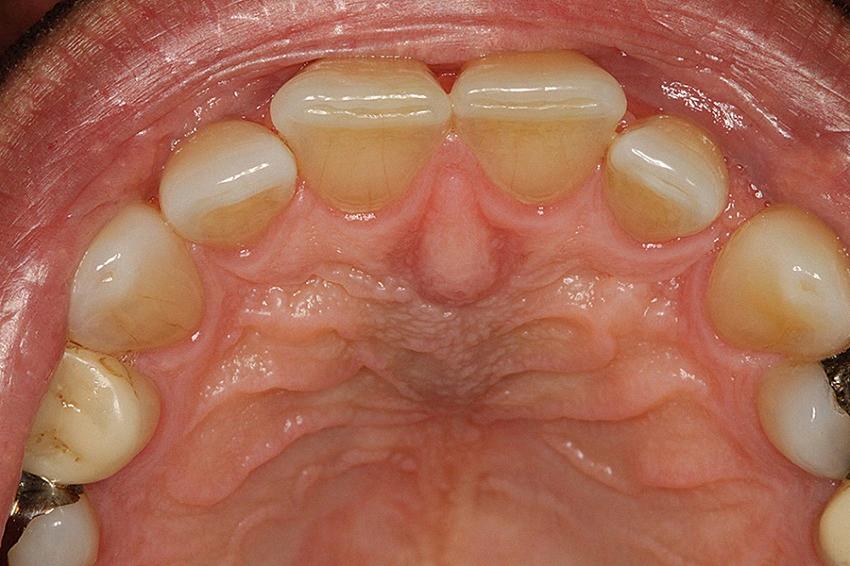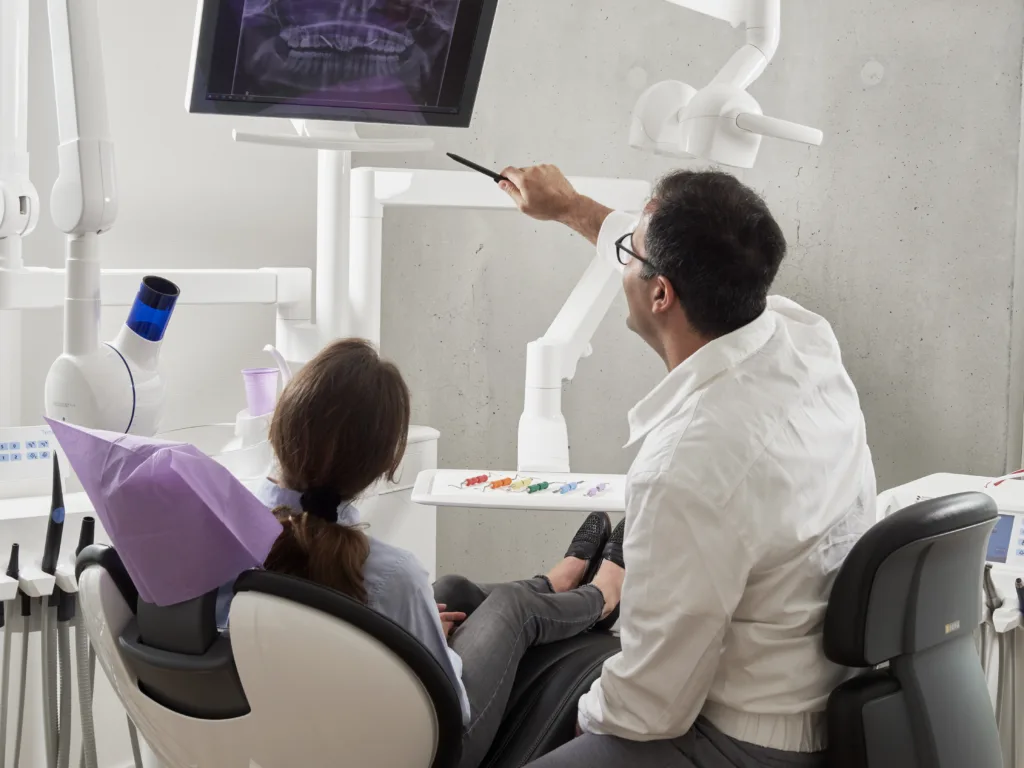The incisive papilla is a small, fleshy protuberance located just behind the front teeth of the upper jaw. It is a normal part of the mouth’s anatomy and is usually redder than the surrounding palatal mucosa. However, sometimes the incisive papilla can become swollen, causing discomfort and pain. In this article, we will discuss the causes, symptoms, and treatment options for incisive papilla swelling.
There are several reasons why the incisive papilla may become swollen. Some common causes include:
1. Trauma: Accidentally biting or injuring the incisive papilla can cause it to become swollen and painful.
2. Infection: Bacterial or viral infections can cause the incisive papilla to become inflamed and swollen.
3. Allergies: Allergic reactions to food or medications can cause the incisive papilla to swell.
4. Nasopalatine duct cyst: This is a type of cyst that can form behind the incisive papilla, causing it to become swollen and painful.
The symptoms of incisive papilla swelling may include:
1. Pain or tenderness in the area around the incisive papilla.
2. Swelling or inflammation of the incisive papilla.
3. Difficulty speaking or eating due to the discomfort.
The treatment for incisive papilla swelling will depend on the underlying cause. Some treatment options may include:
1. Metrogyl (Metronidazole) gel: This medication can be applied directly to the incisive papilla to reduce inflammation and pain.
2. Rexidin (Chlorhexidine) mouthwash: This mouthwash can be used to rinse the mouth and reduce the risk of infection.
3. Warm saltwater rinses: These can help to soothe the area and reduce inflammation.
4. Surgery: In some cases, surgery may be necessary to remove the cyst or other underlying cause of the swelling.
Incisive papilla swelling can be a painful and uncomfortable condition. However, with proper treatment and care, it can be managed effectively. If you are experiencing any symptoms of incisive papilla swelling, it is important to consult with your dentist or healthcare provider to determine the underlying cause and appropriate treatment plan.
Treating an Incisive Papilla Swelling
An inflamed incisive papilla can be a painful condition, and it is important to take steps to treat it promptly. The incisive papilla is a small bump that is located on the roof of the mouth, just behind the front teeth. When it becomes swollen or inflamed, it can cause discomfort and irritation.
One of the most effective ways to treat an inflamed incisive papilla is to use a topical gel or ointment that contins an antibiotic. Metrogyl (Metronidazole) is a commonly used medication that can help to reduce inflammation and promote healing. This gel should be applied directly to the affected area twice a day for five days.
In addition to using a topical medication, it is also important to maintain good oral hygiene. This can help to prevent further irritation and inflammation of the incisive papilla. Using a chlorhexidine mouthwash such as Rexidin can also help to reduce inflammation and promote healing. It is important to note that the concentration of the mouthwash should be 0.2% and it should be used twice a day in water for five days.
If the swelling and inflammation persist even after using these treatments, it may be necessary to undergo a procedure called curettage. This involves removing the inflamed tissue from the incisive papilla to promote healing and prevent further irritation.
Treating an inflamed incisive papilla involves using a combination of topical medications and good oral hygiene practices. If these treatments are not effective, curettage may be necessary. It is important to consult with a healthcare professional for a proper diagnosis and treatment plan.

Source: redalyc.org
Removing the Incisive Papilla
Conventional methods of dental treatments often involve the removal of the incisive papilla, the soft tissue located between the incisor teeth and the labial frenum. However, it shold be noted that the removal of the incisive papilla alone does not address the primary obstacle to tooth movement – the interdental bone.
In other words, removing the incisive papilla alone is not enough to achieve significant tooth movement. In fact, it is the interdental bone that serves as the main barrier to tooth movement. Therefore, it is essential to address the interdental bone for effective tooth movement.
It is important to note that the removal of the incisive papilla is not always necessary and may not be recommended in some cases. The decision to remove the incisive papilla should be made on a case-by-case basis and only after careful consideration of the patient’s overall dental health and treatment needs.
While the incisive papilla can be removed in certain cases, it is not the sole factor that affects tooth movement. The interdental bone must also be addressed to achieve significant progress in tooth movement.
Appearance of an Incisive Papilla
The incisive papilla is a small, fleshy bump located in the palate of the mouth, specifically posterior to the maxillary central incisors. It is typically a shade of red that is more vivid than the surrounding pale pink mucosa. The size of the incisive papilla can vary, but it is usually small and rounded. Its shape can be descrbed as a slightly raised oval or teardrop. The texture of the incisive papilla is smooth, and it is generally not painful or tender to the touch.
To summarize, the incisive papilla is a small, smooth, fleshy protuberance located in the palate of the mouth, behind the maxillary central incisors. It is typically a vivid shade of red and has a slightly raised oval or teardrop shape.
Swollen Bump Behind Front Teeth
If you have noticed a bump behid your front teeth that is swollen, it could be due to several reasons. One of the most common causes of a swollen bump behind your front teeth is a nasopalatine duct cyst.
A nasopalatine duct cyst is a non-cancerous growth that can develop in the area behind your two front teeth. This area is called the incisive papilla, and the cyst can form when the ducts that carry fluid to this area become blocked. The cyst itself is usually painless and often goes unnoticed, but it can become infected or cause irritation.
Other possible causes of a swollen bump behind your front teeth include:
– A dental abscess: This is a pocket of pus that can form in the gums or teeth due to an infection. It can cause swelling, pain, and other symptoms and requires prompt treatment.
– Gingivitis: This is an inflammation of the gums that can cause swelling, redness, and bleeding. It is often caused by poor oral hygiene and can be treated with proper dental care.
– Trauma: If you have recently suffered an injury to your mouth, it could lead to swelling and a bump behind your front teeth.
If you are experiencing a swollen bump behind your front teeth, it is important to see a dentist or doctor for an evaluation. They can determine the underlying cause and recommend the appropriate treatment. Treatment for a nasopalatine duct cyst may involve surgical removal, while other causes may require antibiotics, dental cleaning or other treatments.

Conclusion
An inflamed incisive papilla can be a cause for concern and discomfort. However, with proper treatment, such as Metrogyl gel and Rexidin mouthwash, the inflammation can be reduced and the discomfort alleviated. In cases whre the problem persists, curettage of the tissue may be necessary. It is important to note that the incisive papilla is a normal part of the oral anatomy, but can also develop into a nasopalatine duct cyst if left untreated. Therefore, it is essential to seek professional dental care if you experience any persistent discomfort or inflammation in this area. with the right care and attention, you can ensure the health and comfort of your incisive papilla.
